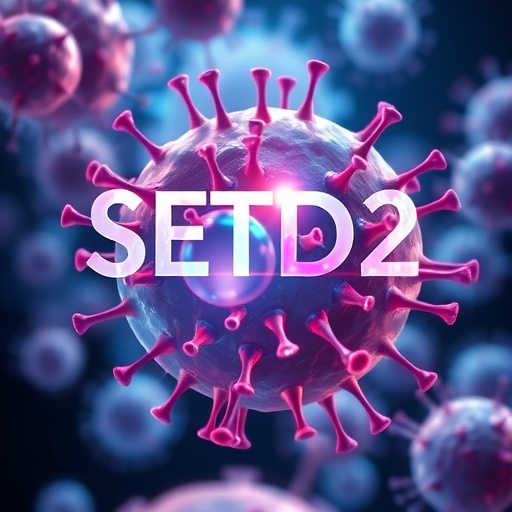The enzyme SETD2 has recently emerged as a critical regulator of immune cell biology, offering promising avenues for therapeutic intervention in a variety of immune-related diseases. As a histone methyltransferase responsible for catalyzing the trimethylation of lysine 36 on histone H3 (H3K36me3), SETD2 plays a fundamental role in maintaining genome integrity and controlling gene expression programs. These epigenetic modifications orchestrated by SETD2 influence not only cellular homeostasis but also the dynamic processes that govern immune cell development, differentiation, and function.
A growing body of evidence reveals SETD2’s multifaceted impact on both innate and adaptive immunity. In the hematopoietic system, SETD2 serves as a gatekeeper of stem cell renewal and lineage commitment. Its activity safeguards hematopoietic stem cells (HSCs) from replicative stress and DNA damage, thus preventing premature exhaustion and ensuring a sustainable pool of progenitors essential for robust immune responses. Loss of SETD2 constrains the regenerative potential of HSCs and skews differentiation trajectories, facilitating genome instability that predisposes to hematologic malignancies.
Within innate immunity, macrophages exemplify the significant influence of SETD2. This methyltransferase suppresses M1 macrophage polarization, a pro-inflammatory state characterized by the secretion of cytokines that exacerbate tissue damage in diseases such as acute lung injury and osteomyelitis. Mechanistically, SETD2 inhibits the activity of hypoxia-inducible factor 1-alpha (HIF-1α), a transcription factor pivotal for glycolytic metabolism and inflammatory gene expression in M1 macrophages. Reduced expression of SETD2 disrupts this regulatory axis, leading to heightened inflammatory responses that amplify tissue pathology. Moreover, in mast cells, SETD2 helps restrain pathological mastocytosis, where its deficiency is linked to the progression of more severe disease phenotypes.
The adaptive arm of immunity is equally dependent on SETD2’s regulatory functions. In T lymphocytes, this enzyme facilitates proper T cell receptor (TCR) recombination, a critical step for the generation of diverse T cell repertoires capable of recognizing a broad spectrum of antigens. Absence of SETD2 results in developmental arrest at thymocyte stages and a marked reduction in mature T cell populations, leading to lymphopenia. Furthermore, SETD2 modulates the delicate equilibrium between regulatory T cells (Tregs) and pro-inflammatory Th17 subsets. By promoting Treg lineage stability and suppressing pathogenic Th17 differentiation, SETD2 helps maintain immune tolerance and prevent autoimmune disorders.
B cell biology is similarly impacted by SETD2 activity, where its role in immunoglobulin gene rearrangement underpins the adaptive immune system’s ability to generate high-affinity antibodies. SETD2 deficiency compromises V(D)J recombination, hindering B cell maturation and antibody diversity. This malfunction opens pathways to oncogenic transformation, as B cells with impaired DNA damage responses accumulate mutations conducive to lymphoma development. In germinal center reactions, SETD2 ensures genomic surveillance mechanisms operate effectively to thwart malignant progression.
At the molecular level, SETD2’s impact extends beyond canonical histone modification. It influences DNA repair pathways, RNA processing, and chromatin architecture, integrating signals that reshape transcriptional landscapes in immune cells. By maintaining genomic stability and fine-tuning gene expression, SETD2 emerges as a pivotal chromatin modifier that couples epigenetic regulation with immune cell fate decisions. These mechanistic insights pave the way for targeting SETD2 or its downstream effectors in a range of disorders from autoimmunity to hematological cancers.
The translational potential of manipulating SETD2 is compelling. Pharmacological modulation could recalibrate immune responses—dampening hyperinflammation in chronic inflammatory diseases, bolstering immunity in immunodeficiency states, or reinstating genomic stability in hematologic malignancies. The challenge lies in deciphering precise context-dependent roles and developing agents that selectively influence SETD2’s function without undermining its essential genomic safeguarding duties.
Recent advances in gene editing, single-cell epigenomics, and proteomic profiling are unraveling SETD2’s complex interplay with immune signaling networks. These technologies will accelerate the identification of biomarkers predictive of disease progression and therapeutic response, particularly in immune-related pathologies where SETD2 aberrations have clinical relevance. Concurrently, animal models deficient in SETD2 provide invaluable systems to dissect its immune regulatory mechanisms in vivo, shedding light on developmental windows where intervention might be most effective.
The discovery of SETD2’s immunological functions exemplifies the expanding appreciation of epigenetic enzymes beyond cancer biology into the realm of immune modulation. SETD2-mediated H3K36me3 marks not only chromatin landscapes but also the functional identity of immune cells, linking metabolic states to transcriptional programs. This integration is crucial in dynamic environments such as infection, tissue repair, and inflammation, where immune cells must rapidly adapt to fluctuating cues.
As the field moves forward, collaborative efforts bridging epigenetics, immunology, and clinical research will be essential to translate these molecular insights into impactful therapies. SETD2 stands at a promising crossroads as both a biomarker and a therapeutic target, inviting further exploration into its nuanced roles across diverse immune compartments and disease contexts.
In summary, the expanding understanding of SETD2 as a master regulator of immune cell development and function heralds a new era in immunoepigenetics. By safeguarding genomic integrity and orchestrating key transcriptional networks, SETD2 shapes immune homeostasis and disease outcomes. Harnessing its regulatory capacity holds transformative potential for treating autoimmune disorders, inflammatory diseases, and hematological malignancies, marking SETD2 as a pivotal molecule in the quest for next-generation immune therapeutics.
Subject of Research: Role of SETD2 in immune cell development and function
Article Title: Emerging Role of SETD2 in the Development and Function of Immune Cells
News Publication Date: 2025
References:
Longmin Chen, Yuan Zou, Yan Dong, Tian Hong, Qianqian Xu, Jing Zhang, Emerging role of SETD2 in the development and function of immune cells, Genes & Diseases, Volume 12, Issue 6, 2025, 101622, DOI: 10.1016/j.gendis.2025.101622
Image Credits: Genes & Diseases
Keywords: Cancer genetics, immune regulation, histone methylation, SETD2, H3K36me3, hematopoietic stem cells, macrophage polarization, T cell development, B cell maturation, epigenetics, autoimmune diseases, hematologic malignancies




